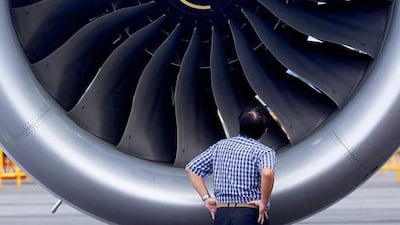The best cure for a fear of flying is to discover the science behind the engines. The sheer research, computer power and analysis that goes into constructing each blade and component is enough to reassure even the most nervous of flyers.
The very first turbo jet engines lasted about 100 hours; today, they can muster some 30,000 hours of flight, or about 10 years. Thanks to the digital age, engineers have made colossal leaps in advancing the airline industry, which has adapted with agility to the new technologies that are under continual development.
The unprecedented number of orders at the Dubai Airshow this year demonstrated the robustness of the industry, and aircraft engine makers such as Rolls-Royce and General Electric are under immense pressure to keep on delivering faster, lighter and more fuel-efficient engines.
It takes years before a prototype is even made. Rolls-Royce, based in Britain, spends US$1 billion annually on research and development. Its latest engine - the Trent XWB, designed for the Airbus A350 family - had about 2,000 scientists and engineers collaborating to bring together 18,000 individual components.
Work began in 2006 and it was four years later that Rolls-Royce began testing the engine - first in Derby in Britain, then in Canada to test for cold-weather climates, and Al Ain was chosen for the hot-weather tests.
At the heart of the engine, the heat is nearly half the temperature of the sun's surface and its pressure is as intense as the ocean depth of half a kilometre.
The engine must power an aircraft that weighs more than 250 tonnes for distances of up to 8,000 nautical miles. It must operate at temperatures between -60°C and 40°C. The high-pressure turbine blades rotate 12,500 times per minute, at twice the speed of light.
Such feats have been achieved, thanks to the semiconductor industry and advancements in microchips.
"The digital age has played a major impact to our business, especially with the computing power in designing the engine," says Richard Hedges, the director of civil aerospace communications at Rolls-Royce.
"The role of semiconductor chips in the future is twofold: one being the actual hardware within the airplanes - using electronics to control various states of the engines. Two for computer power in the design office to model the airflow through complicated structures using 3D [three-dimensional] modelling."
The 3D modelling and prototype testing require accurate and precise simulation and it is in this field where sensors play one of their crucial roles. A typical engine will contain some 300 microchips and sensors. By analysing the data from these chips, engineers can accurately predict the way each component in the engine behaves under various conditions.
"These advanced electronic sensors with microchips within the engines condition the signals. These components are becoming smarter, smaller and lighter and are more efficient when digitally controlled," says Mr Hedges.
Once in the air, Rolls-Royce's vast network of sensors in each engine measures almost every tangible aspect imaginable, from temperatures, pressures, vibrations and oil debris. This data is transmitted in real time back to Rolls-Royce, all of which is monitored and analysed to ensure optimum performance.
The engine parameters of the Trent XWB are checked 40 times per second; the fastest rate a human eye can blink is about three to four times per second. Engineers are able to locate any faults in real time and can almost pinpoint a problem as it happens.
The engines are now mostly digitally controlled. The requirements of an engine differ during the various stages of flight. Rather than manually adjusting the blades or controlling fuel flow, the pilot simply moves the throttles to set the power for the different phases and the microchips and sensors respond accordingly.
The blades are most strained during landing and take-off; the force at take-off exceeds 100 tonnes, the speed at which the air leaves the engine's rear at full power is about 1,600 kilometres per hour.
At landing in particular, pilots require accurate mapping technology to ensure they avoid no-fly areas and head in the right direction. It is in this area where microelectromechanical systems (Mems) have become indispensable.
Now that most airlines are heading towards using aircraft with all digital cockpits, Mems can play a life-saving role for pilots, particularly in those in the military.
Joel Metcalf, a chief engineer at iAccess Technologies, an aviation products and services firm, says that if the entire digital cockpit fails, the Mems will continue to work and provide feedback to the pilots to ensure that they know the longitude, latitude and angle at which they are flying.
As these engines and planes become more digitally sophisticated and as greater connectivity is introduced into planes, the pressure on protecting against cyber threats has become a paramount priority for companies.
Jeff Johnson, the president of Boeing Middle East, says: "In the digital age, when you look at the new airplanes and all the internet infrastructure on the plane, we have to have a firewall to keep cyber threats away. Each interface outside a plane is a risk."
Perhaps in the future, those afraid of flying would not worry so much about an engine failing, but of a cyber attack designed to disable the engine.
thamid@thenational.ae

Digital the engine of aviation technology advancement
Aircraft engine makers such as Rolls-Royce and General Electric are under immense pressure to keep on delivering faster, lighter and more fuel-efficient engines.
Most popular today
